Spiders
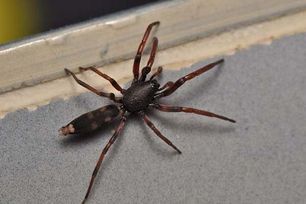
White-Tailed
The White-tailed spider is a medium sized spider with long cigar-shaped dark grey abdomen. The abdomen is grey with two pairs of faint white spots and a distinct white or cream spot at the tip of the abdomen just above the spinnerets. The legs are brown or reddish brown in colour. They are slow moving spiders and travel great distances looking for prey.
Size
Body length: male 12mm, female 20mm
Habitat
White-tailed spiders inhabit cool dark areas under bark and leaf-litter. They often come into houses but are not often seen because the spider is most active at night. They are sometimes found in the folds of clothes, towels and shoes.
Food
White-tailed spiders are hunters who seek out prey rather than catching in a web. They prey on other spiders which they kill while they are in their own webs. The black house spider is a common food item.
Breeding
The female white-tailed spider lays about 80-100 pink eggs in a flattened silk egg sac. She guards the egg sac until the spiderlings emerge. On hatching, the spiderlings are left to disperse to find their first meal.
Range
found in south-east Queensland, New South Wales, Victoria, South Australia, Tasmania and Western Australia, and introduced to New Zealand
Notes
Bite symptoms include local pain, red mark, local swelling and itchiness, sometimes nausea, vomiting, or headache may occur. The bite from these has been linked with spreading skin ulcers and necrosis which has no easy cure yet. Current treatment involves skin grafts to halt the spread of the necrosis. It is thought that the disease is caused by bacteria present on the spider's fangs rather than the venom itself. A study of 130 white-tailed spider bites in 2003 found no necrotic ulcers or confirmed infections. (Of the 130 cases more than 60% of the victims had been bitten by spiders that had wandered into clothing, towels or bedding).
The White-tailed spider is a medium sized spider with long cigar-shaped dark grey abdomen. The abdomen is grey with two pairs of faint white spots and a distinct white or cream spot at the tip of the abdomen just above the spinnerets. The legs are brown or reddish brown in colour. They are slow moving spiders and travel great distances looking for prey.
Size
Body length: male 12mm, female 20mm
Habitat
White-tailed spiders inhabit cool dark areas under bark and leaf-litter. They often come into houses but are not often seen because the spider is most active at night. They are sometimes found in the folds of clothes, towels and shoes.
Food
White-tailed spiders are hunters who seek out prey rather than catching in a web. They prey on other spiders which they kill while they are in their own webs. The black house spider is a common food item.
Breeding
The female white-tailed spider lays about 80-100 pink eggs in a flattened silk egg sac. She guards the egg sac until the spiderlings emerge. On hatching, the spiderlings are left to disperse to find their first meal.
Range
found in south-east Queensland, New South Wales, Victoria, South Australia, Tasmania and Western Australia, and introduced to New Zealand
Notes
Bite symptoms include local pain, red mark, local swelling and itchiness, sometimes nausea, vomiting, or headache may occur. The bite from these has been linked with spreading skin ulcers and necrosis which has no easy cure yet. Current treatment involves skin grafts to halt the spread of the necrosis. It is thought that the disease is caused by bacteria present on the spider's fangs rather than the venom itself. A study of 130 white-tailed spider bites in 2003 found no necrotic ulcers or confirmed infections. (Of the 130 cases more than 60% of the victims had been bitten by spiders that had wandered into clothing, towels or bedding).
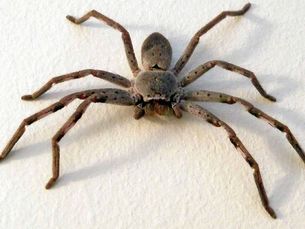
Huntsman
This Huntsman is a large pale brown spider
Size
10-18 mm
Habitat
On or around foliage in forest and woodland
Food
insects that it ambushes
Notes
bites may lead to mild illness but this species is not naturally aggressive towards humans
This Huntsman is a large pale brown spider
Size
10-18 mm
Habitat
On or around foliage in forest and woodland
Food
insects that it ambushes
Notes
bites may lead to mild illness but this species is not naturally aggressive towards humans
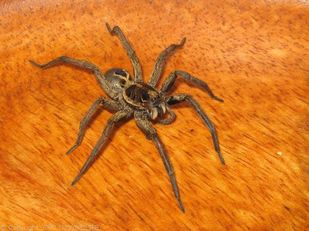
WOLF SPIDER
The Wolf Spider is a hunting spider. Body colours are typically dark grey or brown, with bars of tan, yellow or black. May have pattern of radiating lines on thorax. The spider's underside is lighter coloured. The sides of their jaws have a small raised orange spot. Wolf spiders have eight eyes in three rows, with the four smaller eyes in front and the four largest arranged in a square on top of the head.
They are robust, agile hunters that live on the ground in leaf litter or burrows. They are not good climbers
Size
to 25 mm in body length
Habitat
Ranges from dry inland shrublands and woodlands to wet coastal forests and alpine meadows. They are often found in lawns and gardens and sometimes crawl into homes.
Food
Insects such as crickets and cockroaches, small lizards and small frogs. According to the Queensland Museum, two Wolf spider species are known to be predators of cane toads
Breeding
Mating takes place outside the female's burrow at night. The female constructs a ball-shaped egg sac of white papery silk. She carries it around attached with strong silk to her spinnerets. When the spiderlings hatch, they are carried around on the female's back until they are ready to disperse. Wolf spiders live for up to two years.
Range
Wolf spiders are found throughout Australia.
Notes
Bite is usually harmless with some local pain or itchiness. Less common symptoms include swelling, prolonged pain, dizziness, rapid pulse and nausea.
The Wolf Spider is a hunting spider. Body colours are typically dark grey or brown, with bars of tan, yellow or black. May have pattern of radiating lines on thorax. The spider's underside is lighter coloured. The sides of their jaws have a small raised orange spot. Wolf spiders have eight eyes in three rows, with the four smaller eyes in front and the four largest arranged in a square on top of the head.
They are robust, agile hunters that live on the ground in leaf litter or burrows. They are not good climbers
Size
to 25 mm in body length
Habitat
Ranges from dry inland shrublands and woodlands to wet coastal forests and alpine meadows. They are often found in lawns and gardens and sometimes crawl into homes.
Food
Insects such as crickets and cockroaches, small lizards and small frogs. According to the Queensland Museum, two Wolf spider species are known to be predators of cane toads
Breeding
Mating takes place outside the female's burrow at night. The female constructs a ball-shaped egg sac of white papery silk. She carries it around attached with strong silk to her spinnerets. When the spiderlings hatch, they are carried around on the female's back until they are ready to disperse. Wolf spiders live for up to two years.
Range
Wolf spiders are found throughout Australia.
Notes
Bite is usually harmless with some local pain or itchiness. Less common symptoms include swelling, prolonged pain, dizziness, rapid pulse and nausea.
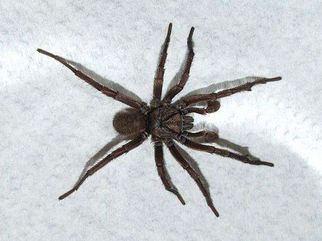
Sydney Brown Trapdoor Spider
The Sydney Brown Trapdoor Spider is a medium-to-large trapdoor spider. Females are larger than males, and more stocky in build. They are chocolate brown in colour and males have boxing glove-shaped palps at the front of the head between the first pair of legs. The body and legs are covered in tiny hairs. They are shy spiders and spend most of the time in their burrows. At night, they wait for food in front of their burrows. The brown trapdoor is often confused with the far more dangerous Sydney Funnel-web. The trapdoor can be distinguished by its chocolate brown colour and less stocky body. Brown trapdoors are shy and timid compared to the aggressive Funnel-webs.
Size
Body length: males 20mm, females 35mm
Habitat
Sydney Brown Trapdoors spiders dig an open burrow in the ground and line it with silk. The burrow may reach 25cm long and around 25mm in width. Brown trapdoors often have silk trip lines radiating from the burrow entrance. They use the burrows for protection, and to raise their young.
Food
Trapdoor spiders eat insects and other invertebrates. The spider waits just inside the burrow entrance and pounces on any prey that walks past. It injecting the prey with venom and drags it down the burrow to feed.
Breeding
During the breeding season, male trapdoor spiders leave their burrows and go in search of a mate during humid weather. Mating takes place in the female's burrow. The female produces an egg sac which she keeps in her burrow. After hatching, the spiderlings stay in the burrow for some time and then disperse to fend for themselves.
Range
found mainly around Sydney
Notes
Sydney Brown Trapdoor Spiders are often mistaken for Funnel-webs, but the bite of the brown trapdoor is not dangerous, although it may cause local pain and swelling. Although not aggressive, they will show their fangs if harassed.
The Sydney Brown Trapdoor Spider is a medium-to-large trapdoor spider. Females are larger than males, and more stocky in build. They are chocolate brown in colour and males have boxing glove-shaped palps at the front of the head between the first pair of legs. The body and legs are covered in tiny hairs. They are shy spiders and spend most of the time in their burrows. At night, they wait for food in front of their burrows. The brown trapdoor is often confused with the far more dangerous Sydney Funnel-web. The trapdoor can be distinguished by its chocolate brown colour and less stocky body. Brown trapdoors are shy and timid compared to the aggressive Funnel-webs.
Size
Body length: males 20mm, females 35mm
Habitat
Sydney Brown Trapdoors spiders dig an open burrow in the ground and line it with silk. The burrow may reach 25cm long and around 25mm in width. Brown trapdoors often have silk trip lines radiating from the burrow entrance. They use the burrows for protection, and to raise their young.
Food
Trapdoor spiders eat insects and other invertebrates. The spider waits just inside the burrow entrance and pounces on any prey that walks past. It injecting the prey with venom and drags it down the burrow to feed.
Breeding
During the breeding season, male trapdoor spiders leave their burrows and go in search of a mate during humid weather. Mating takes place in the female's burrow. The female produces an egg sac which she keeps in her burrow. After hatching, the spiderlings stay in the burrow for some time and then disperse to fend for themselves.
Range
found mainly around Sydney
Notes
Sydney Brown Trapdoor Spiders are often mistaken for Funnel-webs, but the bite of the brown trapdoor is not dangerous, although it may cause local pain and swelling. Although not aggressive, they will show their fangs if harassed.
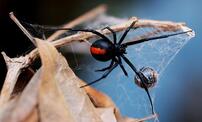
RedBack Spider
Redback spiders feed mainly on ground-living insects that blunder into their webs, but small vertebrates such as lizards and even mice can fall victim.
Also eaten - after mating - are the tiny male redbacks.
A female redback spider can produce eggs for up to two years after a single mating. Eggs are enclosed in 3-5 dirty-white, woolly, spherical egg sacs suspended in the retreat of the web and guarded by the female.
Spiderlings emerge after about 14 days and disperse on the wind as soon as conditions are right. This is how redback spiders turn up in new places or quickly recolonise areas from which they have previously been removed.
Redback spiders feed mainly on ground-living insects that blunder into their webs, but small vertebrates such as lizards and even mice can fall victim.
Also eaten - after mating - are the tiny male redbacks.
A female redback spider can produce eggs for up to two years after a single mating. Eggs are enclosed in 3-5 dirty-white, woolly, spherical egg sacs suspended in the retreat of the web and guarded by the female.
Spiderlings emerge after about 14 days and disperse on the wind as soon as conditions are right. This is how redback spiders turn up in new places or quickly recolonise areas from which they have previously been removed.
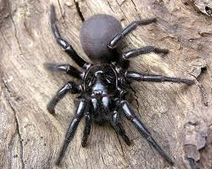
Funnel-Web Spider
The Sydney Funnel-web spiders are some of the world’s most deadly spiders.
There are many species of funnel-web spiders found throughout Australia. Some are dangerous, some are not. The northern,
or tree dwelling, funnel-web spider is not often seen but it is very poisonous. Other species of funnel-webs that live in southern parts of Australia are not dangerous.
- Some funnel-web spiders live in trees.
- Sydney funnel-web spiders live in holes in the ground.
Sydney funnel-web spiders are large black spiders with big powerful fangs, which can be up to 7 millimetres long. The body of the female is about 3.5 centimetres long.
The male is smaller and about 2.5 centimetres long. Their bodies are covered with fine hairs and they have shiny legs.
Male Sydney funnel-web spiders are Australia's most dangerous spider. These aggressive spiders grab onto their victims and bite several times, injecting a very poisonous venom. Some people have died from the bite of these spiders.
Where do Sydney funnel-web spiders live?
Sydney funnel-web spiders live in and around Sydney, in New South Wales, Australia. They live in small, neat holes lined with a collar of silk. The holes are made in shady
places under rocks, shrubs, logs and leaf litter. Silk threads lead away from the entrance to the burrow. These are trip lines and when prey walks into them, the spider dashes out of the burrow to grab it. The spider bites the prey and takes it back into the burrow to eat. Funnel-web spiders prey on and eat beetles, cockroaches, insect larvae, snails,millipedes and sometimes even small frogs and lizards.
Life Cycle
A female mates with a male spider and then lays from 80 to 200 yellow-green eggs, which she wraps in a silk egg sac. She keeps the sac inside her burrow and guards it until the young spiders, called spiderlings, hatch about three weeks later. The spiderlings share their mother's burrow for a few weeks before wandering off to find a place of their own to live. Males die a few months after mating but females can live and breed for several years.
Can funnel-webs swim?
Wandering funnel-webs spiders often fall into backyard swimming pools and they can stay alive for hours. They can't swim but they can trap a small bubble of air in hairs around the abdomen, which aids both breathing and floating, so it should not be assumed that a spider on a pool bottom has drowned. As they gradually get waterlogged, their buoyancy decreases and they eventually sink and drown. Funnel-webs have been known to survive 24-30 hours under water.
Can funnel-webs jump?
Despite what many people think, funnel-webs can' t jump. However they can move quickly, and they will rear up when irritated and make sudden lunges when striking
The Sydney Funnel-web spiders are some of the world’s most deadly spiders.
There are many species of funnel-web spiders found throughout Australia. Some are dangerous, some are not. The northern,
or tree dwelling, funnel-web spider is not often seen but it is very poisonous. Other species of funnel-webs that live in southern parts of Australia are not dangerous.
- Some funnel-web spiders live in trees.
- Sydney funnel-web spiders live in holes in the ground.
Sydney funnel-web spiders are large black spiders with big powerful fangs, which can be up to 7 millimetres long. The body of the female is about 3.5 centimetres long.
The male is smaller and about 2.5 centimetres long. Their bodies are covered with fine hairs and they have shiny legs.
Male Sydney funnel-web spiders are Australia's most dangerous spider. These aggressive spiders grab onto their victims and bite several times, injecting a very poisonous venom. Some people have died from the bite of these spiders.
Where do Sydney funnel-web spiders live?
Sydney funnel-web spiders live in and around Sydney, in New South Wales, Australia. They live in small, neat holes lined with a collar of silk. The holes are made in shady
places under rocks, shrubs, logs and leaf litter. Silk threads lead away from the entrance to the burrow. These are trip lines and when prey walks into them, the spider dashes out of the burrow to grab it. The spider bites the prey and takes it back into the burrow to eat. Funnel-web spiders prey on and eat beetles, cockroaches, insect larvae, snails,millipedes and sometimes even small frogs and lizards.
Life Cycle
A female mates with a male spider and then lays from 80 to 200 yellow-green eggs, which she wraps in a silk egg sac. She keeps the sac inside her burrow and guards it until the young spiders, called spiderlings, hatch about three weeks later. The spiderlings share their mother's burrow for a few weeks before wandering off to find a place of their own to live. Males die a few months after mating but females can live and breed for several years.
Can funnel-webs swim?
Wandering funnel-webs spiders often fall into backyard swimming pools and they can stay alive for hours. They can't swim but they can trap a small bubble of air in hairs around the abdomen, which aids both breathing and floating, so it should not be assumed that a spider on a pool bottom has drowned. As they gradually get waterlogged, their buoyancy decreases and they eventually sink and drown. Funnel-webs have been known to survive 24-30 hours under water.
Can funnel-webs jump?
Despite what many people think, funnel-webs can' t jump. However they can move quickly, and they will rear up when irritated and make sudden lunges when striking

